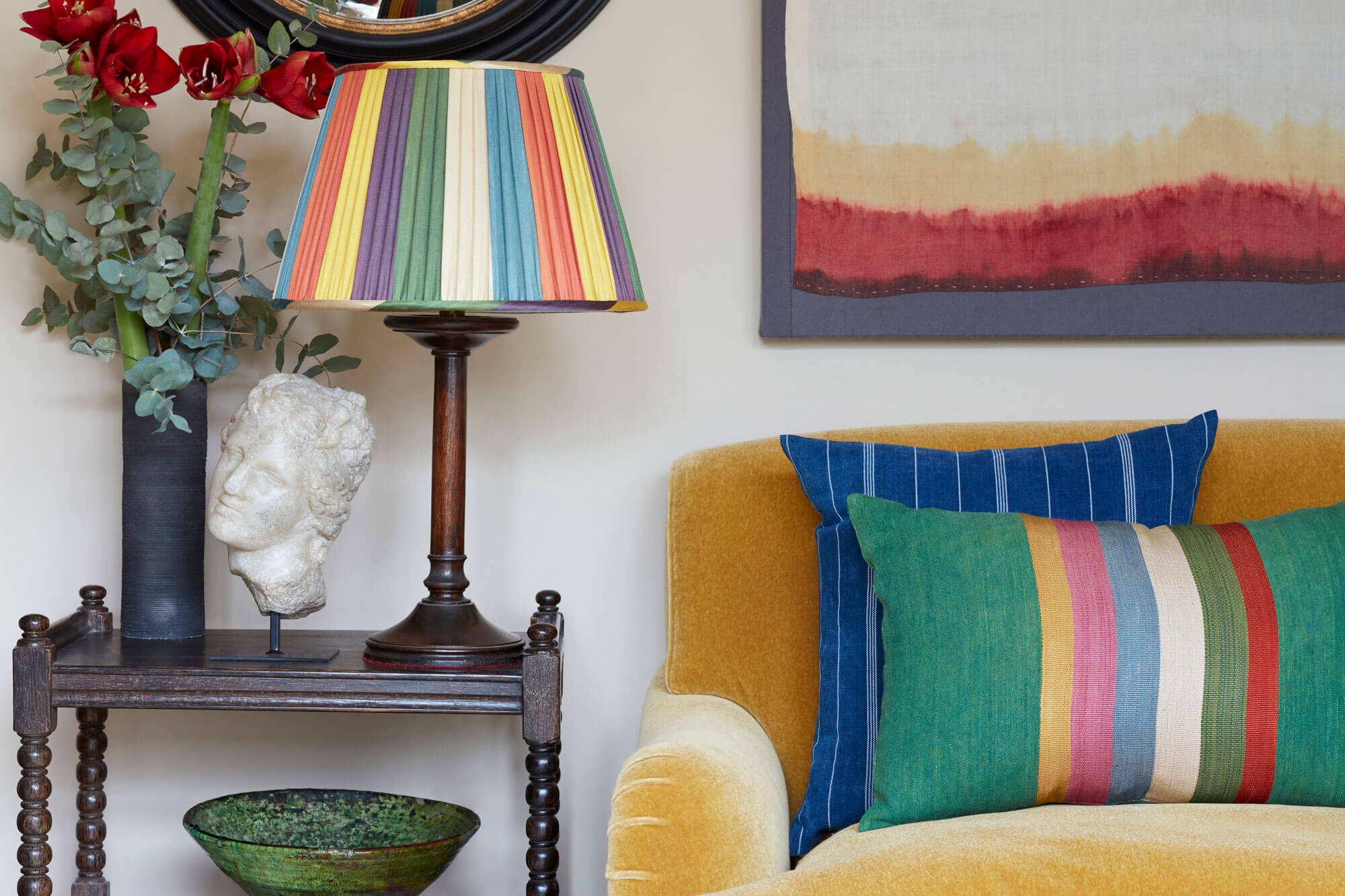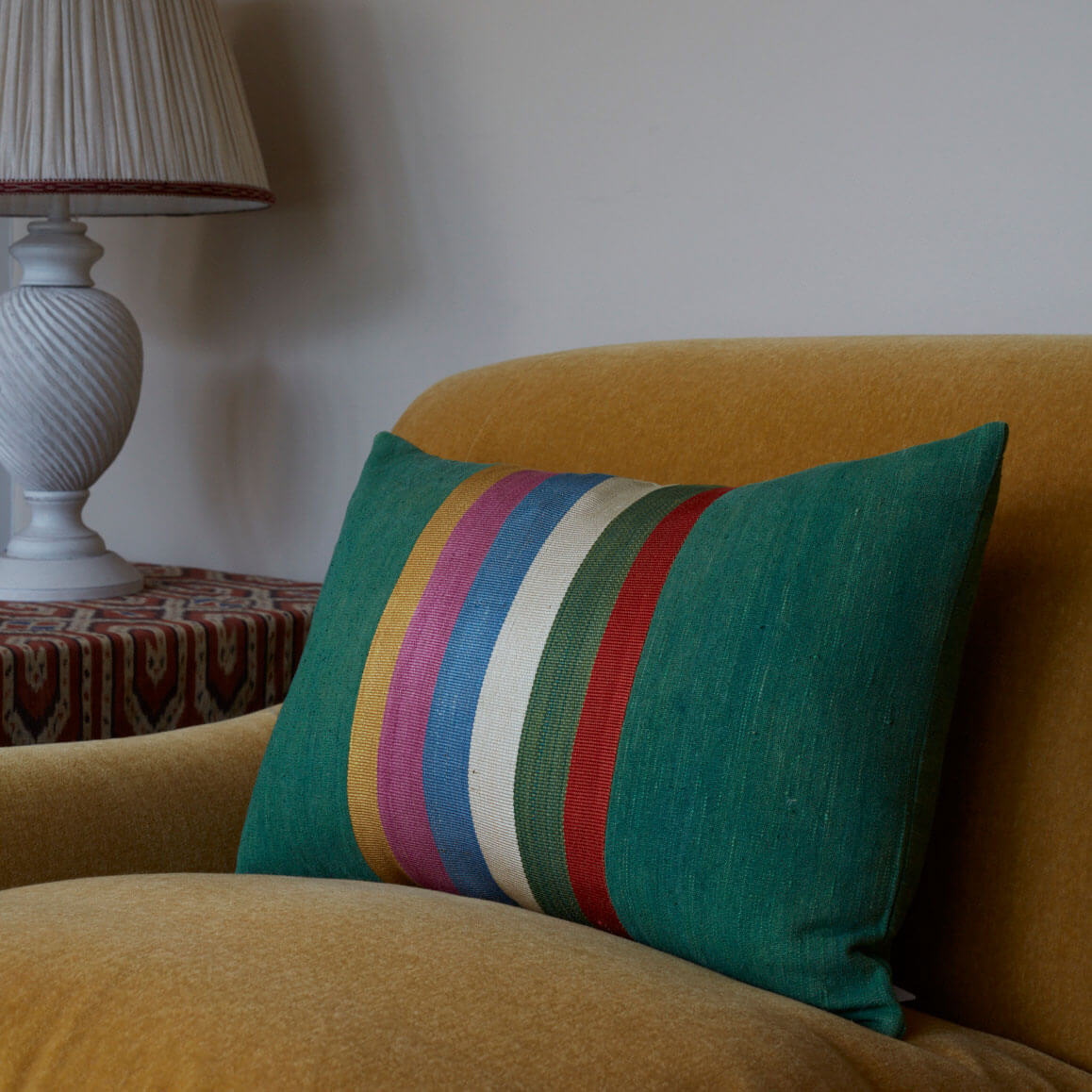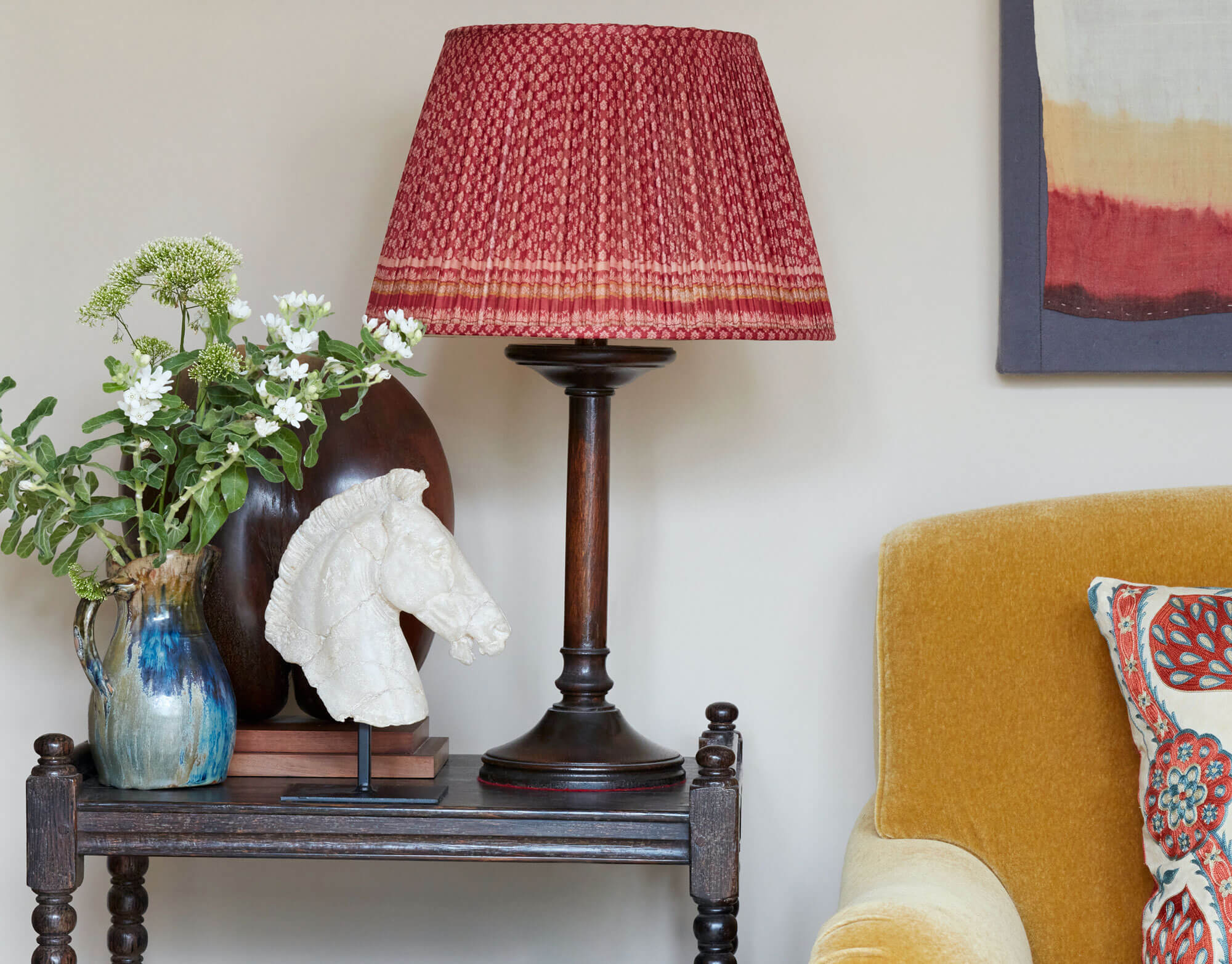Knowledge Centre
How does the Ikat weaving method work?
To watch a traditional silk Ikat being woven is to be taken into the mesmeric fold of ancient fabric design. The chromatic waves emerging from the skilled hands of the weavers are produced by the methodical interlocking of dyed silk yarns, which coalesce to form washes of colour and intricate patterns. 37 steps include weaving and dyeing of ‘resist-dyeing,’ parts of the yarn take on the brilliant colours yielded from natural materials like St John’s Wort, turmeric, chamomile, poppies, cherry skins and tulip petals. The fine strands of silk are marked and wrapped with rubber is applied to lengths of the silk to shield them from the dyes, which is then removed and repositioned so the next colour can be applied up to seven times, from the lightest to the darkest hue. The yarns are then woven by hand to a maximum width of 40 centimetres, a process which allows master weavers to produce up to 10 metres a day.
What strikes you most about the unique patterns produced by the Ikat dyeing technique?
Ikat fabrics possess a depth of colour and a quality of line that is unrivalled amongst other varieties of dyed, patterned fabrics. They are delightfully unusual and individual in their sprawling chevrons and filigree curves. It is the unpredictability of ikats, their rejection of uniformity, that gives the fabrics their charm. The waterfall of colours produced by the merging dyes gives each in the design a sense of ephemerality: An aubergine warmth quickly fades to glorious mustard, a deep scarlet spreads through a rich maroon into fresh green and beyond.
Can exactly the same print ever be achieved twice with the traditional methods?
It is almost impossible for the master weavers to produce two identical lengths of Ikat. The dyes have an autonomy of their own, often spreading unevenly between the rubber wrapping to give each colour an original coverage. Combined with the unstable weather conditions and the whims of the dyers and weavers, each finished length will possess its own colourful personality, its own quirks and flourishes distinct from anything that has come before.
What does an Ikat fabric/accent bring to an English home?
Using an accent of Ikat in an English home will imbue any of its rooms with a taste of the East. Ikats bring colour, pattern, and the warmth implicit in both, to the backdrop of English life. Our tea-stained interiors revel in the presence of the ikat’s cascade of colour. The beauty of a traditional English home is its grounding in the eclectic. Antique wooden furniture, overlapping rugs and Tuareg mats, worn tweed upholstery and chipped willow pattern vases congregate into a diorama of layered textures and patterns, delightfully disrupted by the jolt of an ikat lampshade or cushion.
Jajim fabrics are steeped in tradition. Does the essence of this time-honoured narrative come through in Nushka’s silk Jajim offering?
The story behind our jajim cushions is a tale of salvage. Antique jajim fabrics, often used as wedding gifts and scarves, are found littered throughout Azerbaijan; diamonds in the rough, awaiting their second lease of life. They are gathered and sourced by artisans and master weavers in their torn, fragmented form, and lovingly restored and adapted for modern use. The restoration process is an alchemy of its own creation. The artisans hand-dye silk threads to a colour match in the original jajim, picking out a colour from the coalescence of stripes and rows and spinning a new measure of fabric into existence that extends the jajim, not only in a physical sense, but also its lifespan. What is most impressive about the way these jajims are reawoken and celebrated is the way the colour combinations and designs, some dating back to the 1920s, appeal to the 21st century audience.
What strikes you most about the unique patterns produced by the Jajim weaving technique?
The route that a jajim takes to one of our cushions is a long one. The original fabric will pass through many iterations before it is taken under the wing of an artisan who begins to restore and adapt the fabric into a more usable form for contemporary homeware. In this way, the most striking element of a jajim is the combination of old and new, unified by the time- honoured craft and techniques applied to it over its lifespan. The sensitivity of the jajim’s treatment at the hands of the weavers and dyers, and their unwavering respect for the sacred pattern, results in a refreshed length of fabric which is just as beautiful as the original fragment.
How does a silk Jajim accent/cushion contribute to the look and feel of a space?
Jajims work to contribute to the sumptuous layering of pattern and colour in considered, British homes. The curation of jajims at Nushka has a strong taste of the East, elevating other popular fabrics like suzani and indigo in eclectically decorated rooms. But beyond the unusual colours and patterns a jajim will bring into a living space, their soft, silky tactility us unrivalled. This can bring the mere act of sitting on a sofa or armchair a true feeling of refinement. At Nushka, we believe that the home is about cultivating this very sensation in everyday actions, generating little moments to inspire a smile. This could be the feel of a hand-woven rug underfoot, the pleasure of placing a cup of tea on an African dyed raffia coaster or the artful pleats in a colourful Ikat lampshade in an otherwise-unassuming corner.
Can you describe the process of making a suzani fabric, original uses and heritage?
Although the name itself describes the needlework involved in creating a traditional Suzani fabric, the dying process is the most magical part. The rarity of the craft adds to this sense of alchemy that produces the vibrant, distinct colours of our hand-embroidered silk Suzani cushions. Suzani is a type of embroidered and decorative tribal textile made originating in Central Asian countries, usually featuring a cotton fabric base, we have been able to source several high-quality weavings where the base is made from silk and embroidery threads are also silk.
How do you source suzanis? Apparently the fresher and brighter the fabric, the more likely it is to be an authentic piece dyed with vegetal dyes...
Our Suzani fabrics are sources in sprawling bazaars in Uzbekistan and Turkey. When we source the fabrics for our cushions, we look for different elements of what makes suzanis beautiful. Sometimes it’s precision and symmetry, other times it could be naivety of line, boldness and subject matter. Popular design motifs include sun and moon disks, flowers including tulips, carnations, and irises, leaves and vines, fruits such as pomegranates, and occasional fish and birds.
Why are you drawn to suzanis? What do they bring to the Nushka collection? Why are they special?
Suzanis work so well in English interiors, bringing a surge of Eastern vitality, colour and pattern to the most reserved of homes, set against a backdrop of rolling hills and cloudy skies. The variety of the patterns in the Suzani category brings another layer of interest to these spaces, demarcating the very structured, British repeats from the free-flowing, exotic patterns of Uzbekistan.
Our Suzani cushions allow our customers to introduce a jolt of these pomegranate-laden, be-petaled fabrics without committing to a large panel, the form in which Suzanis are usually produced and which often exceed two metres in length. In this way, a Suzani cushion is something rare, original, and accessible for the cosiest of London apartments and the most rambling of country homes.
Which rooms are the best hosts for suzani accents? Bedrooms, living rooms?
Suzani cushions work as vibrant, conversation-starting accessories in any room, from living rooms to bedrooms, and from kitchen banquette seating to the characterful bathroom armchair. Place a Suzani cushion in any room in which you would like to make a lasting impression, on its own or as a cluster to highlight the subtle differences in each individual length of fabric. They are woven to be admired.
Where and how do you source your saris? Are they vintage fabrics or do you have them made?
Sourcing vintage saris from India is a pleasure that we relish. Discovering these exquisite, silken swathes of characterful fabric is a visceral and colourful experience. It takes time to look for the right saris, ensuring that the translucency or opacity, pattern, colour and strength of the material can withstand and flourish in its new life as a pleated lampshade. Some of the saris are up to 40 years old, and even the newer silks can be extremely delicate. The way we salvage, repair and breathe new life into these fabrics saves them from disposal and waste. It is important to consider such beautifully and carefully crafted fabrics as entities beyond their lives as garments and to reimagine ways to extend their lifespan as decorative fabrics. Our silk sari lampshades bring elements of the past into the sphere of modern living.
What makes sari material so good for use as lampshades?
The fine silk of our vintage saris relaxes into the pleats of our empire lampshades very naturally, making them an obvious choice for Nushka’s lighting offering. Depending on the particular sari and how fine the material is, sometimes the silks need to be doubled to give the light the right level of coverage. In some special instances, the colours of the sari can also affect the glow from the bulb within, giving a more golden or cooler tone to the room. It is also true that these lampshades are not solely functional, but are decorative pieces in their own right. They look just as good switched off as they do illuminated in the evening. They provide another textural, patterned layer to complement eclectic, globally-inspired interiors, the pleats shrouding and exposing the intricate patterns in miniature crests.
Any comments on the nature of using clothing fabric in the home?
There is such a vast variety of Indian fabric designs and prints that continue to serve as inspiration for textile designers to this day. The inviolable link between fashion and homeware is particularly prevalent with Eastern design. Indian motifs and the textures and colours of the silk saris translate so seamlessly from the elegant drapery of traditional garments into one-off pieces for the home. We see the materials as works of art, not static, limited or obligated to any one use.
What, to you, makes the perfect sari fabric for a lampshade? Is it to do with how the pattern repeat works as a pleat?
We are endlessly experimenting with different patterns, colours and varieties of silk saris to find new and innovative ways to make use of the vintage fabrics we source. The patterns with larger-scale motifs create a totally different finish to fabrics with a tighter, floral repeat, while different fabric and colour combinations affect the final shade ever still. It is all down to interpretation, and of course, the kind of vintage fabrics we are able to source. This making process, so contingent as it is on our supply, makes each piece the result of research, travel, craft and care.






